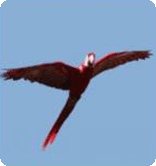Macaw Screaming

Grover, my B&G Macaw screams every time I leave the room. How can I make him stop? Thanks, Steve.

What a great question Steve. Why on earth should a macaw vocalize when a human species leaves it’s vicinity? What function could it possibly serve? When screaming is ongoing, if we stop to think about it for a few minutes, we could say that those vocalizations serve some purpose for Grover. He gets something out of it. Otherwise, why be bothered wasting time and effort to behave in such a way. What that purpose might be is up to us to find out.
Parrots, like most species on this planet, behave in ways that work for them in their current living situation whether that be free range or captive. That work in ways that are effective, relevant and cost the individual the least amount of it’s available resources both behaviorally and physically. In other words, each individual does what works for that individual, in any particular situation, as it wanders through life finding out what has value and what should be avoided.
Using the previous comment as a starting point, we can infer that Grover gets something from those screams of his. If we could discover what purpose those screams might serve, that can form the basis for any intervention in a sound, scientific, respectful and VERY humane way. When you think about it , behaviors that are ongoing, generally occur for only a couple of reasons. Either Grover is vocalizing “to get” something in the surrounding environment or to escape or avoid that which has produced unpleasant consequences in the past. It can be that simple and that complicated trying to deduce what is maintaining any behavior.
What is wonderful Steve, is that you’ve identified a specific context in which Grover vocalizes. If you leave the room, Grover screams. So we now know what set’s the scene for the behavior to occur. What we have here is one half of what’s known, in Applied Behavior Analysis, as a Functional Assessment (FA) . To complete our assessment, we would need to know what currently maintains the behavior. In other words, what does Grover “get” when he vocalizes?
How can we discover what might be reinforcing Grover’s behavior? By looking at the Grover’s surroundings and everything that happens immediately before and after the screaming. Part of that environment includes Steve and his reaction to Grover’s “yodelling”. You see, very often with captive parrots any excessive vocalizing is a learned behavior that occurs when the bird is soliciting attention from the caregiver.
If our hypothesis is correct we could say:
WHEN: Steve leaves the room
BEHAVIOR: Grover screams
TO GET: Steve to look at or talk to him
Prediction of Future Behaviour: Grover will scream more
Bingo! That look or word is often all that is needed. No matter if it is an annoyed or disgusted look or a less than friendly “shut up!”, “stuff it” or any of the other myriad of phrases we humans are prone to come up with. Grover has gotten your attention. That is especially true if you don’t comment or look at him all the time. Intermittent reinforcement does make for very persistent behavior on the part of our birds.
Does that mean we can’t change the behavior? NO! If we want to alter one behavior, we should be replacing it with another that is of equal value to Grover. Fair is only fair is right? If we identify another behavior that serves the same function and reinforce that while ignoring Grover’s excessive vocalizations we can meet that target. For instance, if you recognize Grover for making any sounds that are pleasant to your ear (talking, whistling,etc) and provide lots of feedback in the form of your attention for that then the screaming will serve less of a function for Grover. In other words, it will no longer be worth the extra effort it takes to make loud noises.
Another tactic might be to preempt the behavior before you leave the room by chatting with Grover for a few seconds and telling him you’ll return shortly. As with humans, often those few words will be enough. Teaching him to find other reinforcement through foraging and toy playing could also be considered. Not all birds have learned how to interact with the “cage decoration” we put in their cage.
That doesn’t mean that any given bird will not have it’s moments of exuberance for life. It simple means that excessive “screaming” will reduce if we offer immediate praise and attention for behaving in ways that we appreciate and don’t require ear protection.
All in all Steve there are a number of ways that you can reduce the loud noises Grover makes when you leave the room.
All the best,
Lee

































